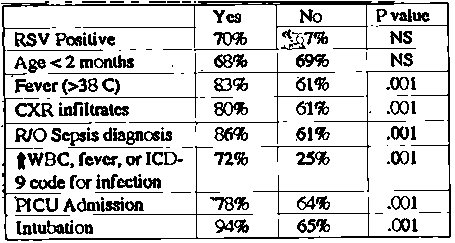
Associatoins with antibiotic user :

| 11 th Annual Pediatric Critical Care Colloquium |
| Session/Time | Pulmonary I/Thu, 9:45 - 12 00 PM |
| Title | Antibiotic Use in Bronchiolitis in Children’s Medical Centers |
| Author | D Willson, S Hom, and Members |
| Affiliation | The Rating of Illness Severity in Kids (RISK) Study |
| Introduction | Bronchiolitis is an acute viral illness of the lower respiratory tract and is a common cause of hospiwization in infants. A variety of viral causative agents have been identified, chief among them RSV. Therapy is supportive and, unless there is superimposed bacteria] irdection, antibiotics are not indicated. Despite this, antibiotics are frequently prescribed. We evaluated antibiotic use in children with bronchioli6s in 10 children's medical centers over an I8 month period. |
| Method | Consecutive chart reviews of all children admitted with the diagnosis of "bronchiolitis" (ICD-9 466.1) in 10 children's medical centers. |
| Result | 809 patients were identified, 416 of which
were RSV+. Percentage antibiotic use is as shown:
Associatoins with antibiotic user :
|
| There were also significant differences in prescribing practices among the 10 centers, with a range of 41 % to 8I % of children receiving antibiotics during hospital stay. | |
| Conclusion | Despite the viral etiology of bronchiolitis, antibiotics are frequently prescribed for hospitalized patients, even in children's medical centers. Such practice is incompletely explained by suspected co-existent bacterial superinfection, young age, presence of fever, elevated WBC, or infiltrates on CXR. The Variation in practice across 10 children's medical centers and the high frequency of use in children with proven viral equation (RSV) of their bronchiolitis suggests that this practice is inconsistent and irrational. Antibiotics are overutilized in children with bronchiolitis. |
Use your browser's back button to return to the appropriate index of abstracts...
Back to PCCC 98 Abstract Introduction | Back to PCCC 1998